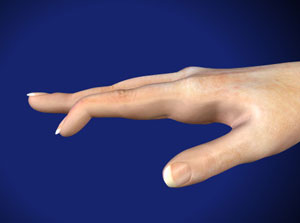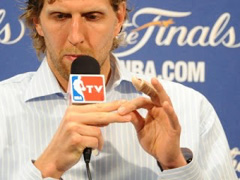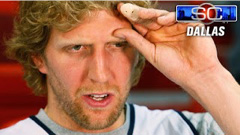
Mallet Finger (Baseball Finger)
A mallet finger occurs when the extensor tendon at the tip of a finger ruptures. The rupture of this tendon can involve the tendon alone, be associated with a small bone fragment or fracture or can be associated with a fracture that requires significant care.

A mallet finger often begins with pain at the distal joint of the finger. At times there is an immediate loss of motion while at other times the finger seems to stay straight for a while and only later starts to lose its ability to be extended actively at the tip. These injuries are typically "closed" in that the skin and nail is intact but at times there is an injury to the skin or nail bed as well. The injury may seem "closed" but actually is "open" and can become infected at times. In severe cases the injury is clearly associated with an open injury to the joint or bone, a so called open or compound fracture. Sharp or penetrating injuries can cut the tendon and enter the joint as well but treatment of those sharp injuries may not follow the same treatment as a typical mallet finger does.
In adults the injury can involve the joint surface. In children it can involves the growth plate or physis.
The diagnosis is often made based upon the type of injury and the appearance of the finger. The fingertip will droop down and there is a loss of active motion. Often the finger can be passively pushed up to straighten it but the independent active motion to extend the digit at the tip has been lost
X-rays are often taken to further delineate the injury and see how much if any bone, joint or growth plate is involved
Treatment depends largely upon the extent the soft tissue and underlying boney injury.
Tendon Rupture without Bone Injury

Types of splints used to treat mallet finger. A, Dorsal aluminum splint. B, Commercial splint.
Most of these mallet finger injuries can be treated with splinting. The splint can be applied in a variety of ways depending upon the injury. Typically the split is left in place full time for six to eight weeks with a time for part time splinting after that depending upon what daily activity is done by the patient with a typical part time period of 6 – 4 weeks more. In some situations pinning of the joint is used rather than a splint.
Tendon Rupture with a Small Bone Fragment
These injuries typically are treated like non-boney injuries
Tendon Rupture with a Large Bone Fragment Involving the Joint
These injuries may respond to splinting and splinting is often used however a small bump may always be present a t the joint. At times if the doctor feels that that the bone fragment is large enough and the joint may be unstable surgery may be offered. During surgery pins or small screws may be used and the joint itself may be pinned to prevent motion during the healing process.
Above: X-rays showing fracture at the insertion of the extensor tendon. In the first image on the left the fragment is displaced. This will heal with a bump but will be able to be treated with a splint. IN the image on the right the joint has subluxated. This subluxated joint can need in certain instances to have a surgical repair.
In adults with severe open injury more immediate surgery may also be offered
Children

Mallet deformity from a fracture across the growth plate in a child is different than the adult fracture or tendon avulsion.
In children the doctor needs to differentiate between these injuries that require reduction or realignment of the bone without surgery and those who may have a portion of the nail bed significantly torn or retained within the fracture site or growth plate. Often children will not have a tendon injury but a fracture through the physis which appears to be a mallet injury. X-rays often will reveal this.
Late or Delayed Treatment in adults
Delayed treatment of mallet finger deformity may consist of splinting initially and at times surgical methods are offered to correct chronic deformities and other associated joint and tendon problems that may accompany the chronic situation
Results

Swan neck deformity from tendon imbalance and laxity at the proximal joint.
Most mallet fingers heal well, although often there is a slight loss of full extension. The slight extension loss typically has no effect on hand or finger function, but if left untreated it can cause other issues to occur in the finger due to tendon imbalance. While treatment of a closed mallet finger is not an acute emergency, the improper, partial or untreated injury can lead to further problems such as a swan neck deformity.
Note: Some material ( written and photos) taken from http://orthoinfo.aaos.org/topic.cfm?topic=a00018
Is Activity Possible with a Mallet Finger
Yes activity is permitted. Even encouraged as one needs to keep the other joints of the same finger and the other fongers moving. Much depends upon who you are and what you do but most do normal activity when this problem is being treated. The exception may be a child or someone who work environment does not permit it. Sports can be played but risks of injury or the difficulty while playing a sport or doing certain activities productively may outweigh the need depending upon the circumstances.
Dirk Nowitzki helped Dallas win the NBA finals in 2011 with a mallet finger injury


Treatment for a Typical Mallet Finger
Typical treatment with an alumifoam splint for mallet finger injuries.
8 weeks full time splinting, 4 weeks part time splinting.
Full time splinting of the DIP JOINT distal interphalangeal joint (8 weeks). During this time the splint is usually applied to the dorsal side or nail side of the finger. It is important to make sure the splint keeps the fingertip straight. Many times the splint is placed without attention to this detail and the result will be compromised. A layer of coban can be applied first, followed by the splint with tape and additional tape or coban over that to cover. The skin must be kept clean. This means removing the splint and washing or using alcohol based hand sanitizer to clean. Make sure there is no redness or skin breakdown. If so at times one may switch the splint to the underside of the finger for a few days. BUT splinting on the palm side may result in slight bending within the splint or it may block motion of the adjacent proximal interphalangeal joint, (the PIP joint).
It is easiest to shower with the splint on, covering it with a bag, and then removing the splint for skin care.
DO NOT MOVE THE FINGERTIP WHEN UNSPLINTED FOR 8 WEEKS. It may be tempting to do so, but it can stretch out the tendon.
HOWEVER, The PIP joint must be MOVED so it does not get stiff.
After 8 weeks then part time splinting begins for 4 weeks
PART TIME (4 weeks) This phase is night-time (or sleep -time) and heavy activity.
DO NOT push the fingertip down but let the tip gradually get its motion. You may see a droop at the middle or end of the day but that is why there is nighttime splinting. If you do not nighttime and part time splint for 4 weeks or if you try to stretch the joint out, you may get a recurrence.
ALWAY CALL OR ASK IF YOU HAVE QUESTIONS or PAIN or SKIN IRRITATION
If you are having issues with the alumifoam splint then alternatives are always possible, no one splint may be right for everyone.
Alternatives to splinting this way may include casting in therapy, or a different type of splint.
The successful treatment of these injuries is relatively simple in many ways but time consuming and there is great need for attention to seemingly minor details.
